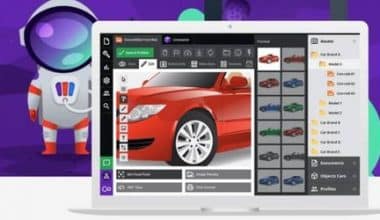Some firms are increasingly opting to lower their initial investments in IT infrastructure by moving their applications into cloud environments. These environments provide a variety of cloud alternatives, including private, public, and hybrid configurations. Because of this, it’s crucial to have a cloud management (CM) plan that enables businesses to choose how and when to employ cloud-based services, ensuring that doing so is both efficient and affordable. Just as they might provide you with services that you can use directly, cloud management providers can also offer you a service to rent a server where you can deploy your services. In this blog post, we shall talk about multiple and hybrid cloud management, its service, and its platform.
What is Cloud Management (CM)?
The structured management of cloud computing products and services is known as “cloud management.” It refers to the procedures, plans, regulations, and tools that are employed to manage and keep both public and private clouds, hybrid clouds, and multi-cloud environments under control.
You probably work on the cloud totally or in part right now. To evaluate, monitor, and manage cloud computing resources, infrastructure, and services as effectively as possible, your firm needs a system.
Numerous underlying responsibilities, including resource provisioning and orchestration, automation of cloud consumption and deployment, resource lifecycle management, cost reduction, performance monitoring, and security, are necessary to keep your cloud environments operating successfully.
How Does Cloud Management Work?
The deployment and operation of your cloud applications and services across public cloud, hybrid cloud, or multi-cloud environments can be managed with the help of CM tools. Making educated decisions about how to operate workloads will be made possible with the aid of a solid cloud management platform, which will assist you in tracking and monitoring consumption and performance for each component of your cloud infrastructure.
CM software and tools are typically installed as virtual machines, each with its server and database. APIs are used by servers to interface with resources in your cloud environments. A dashboard that can be viewed through a web interface can be created by collecting activity in cloud-based applications, performance data, and other events. Administrators can use cloud management tools from anywhere as long as they have a secure connection, just like you can with your cloud resources.
With reporting capabilities across cloud apps to gather performance and usage statistics, produce insights, and send alerts, the majority of cloud service providers offer CM as a service within their platforms. When businesses operating in a hybrid or multi-cloud environment need to report across different providers, however, this may present issues. With simple connectors and open platforms, top cloud providers will also make it possible for you to synchronize your CM tools.
Cloud Management Service Features
Tools and technologies for CM provide strategies and processes that let you efficiently manage cloud-based assets and applications, streamline automated workflows, and make cost-effective decisions about your cloud charges and usage.
The following list of typical CM features:
#1. Automation
Application administration can become monotonous, especially if your environment is huge. Programmatic resource management is made possible by CM, which also offers continuous integration, automated capacity management, and orchestration to ease operational stress.
#2. Compliance and governance
Although moving to the cloud can entail giving up some control over your core infrastructure and applications, you’ll still need to be able to manage access and comply with regulations. By alerting you to problems so you can fix them right away, CM enables you to make sure cloud users and configurations comply with corporate policies and regulatory requirements.
#3. Security
Since protecting your data, applications, and services in cloud settings is a joint duty between you and your cloud service provider, cloud management is crucial. Leading CM technologies provide machine learning capabilities for effective threat identification and intelligence, as well as to streamline security operations and monitoring.
#4. Monitoring and logging
CM makes it possible to observe what’s happening across your environments with the help of monitoring and logging events. You may detect mistakes, automate incident management, and enhance performance by gathering, analyzing, and correlating log data.
#5. Cost and performance reporting
If you do not pay close attention from the beginning, the costs of cloud computing could easily exceed your budget. To give you a clear picture of how and when resources are being used, cloud management offers cost management, reporting, and forecasting. This can help you allocate resources more wisely, determine whether you’re getting what you pay for, and cut out wasteful expenses.
Cloud Management Platform
IT businesses need to be able to use APIs that draw data from every application in their hybrid cloud or multi-cloud environment — they need a cloud management platform (CMP)—to obtain the visibility and control necessary to manage efficiently.
An IT organization can create a structured approach to security and IT governance that can be used throughout its whole cloud environment with the aid of a CMP. Enterprise IT businesses may manage compliance, create real-time monitoring and alerts to stop data breaches and cyberattacks and optimize and secure their cloud applications with the help of a cloud management service platform.
Several factors are driving the increased adoption of the cloud computing model and infrastructure-as-a-service (IaaS) by enterprise organizations. Cost savings are the primary and most significant factor. Leasing computing power and data storage from a third party on an as-needed basis is significantly less expensive than building the same capabilities internally.
How CIOs and IT managers must handle IT costs, compliance, security, and asset management has changed as a result of the widespread adoption of cloud technology in the business environment. Enterprise CIOs can keep control over a more diverse ecosystem of cloud computing technologies thanks to software solutions for CMP.
What Should a Cloud Management Platform Do?
When choosing where to run workloads, a user should be able to see how and when each component of the cloud infrastructure is being used, thanks to a good cloud management platform. Users should be able to monitor the performance of cloud-based applications, identify bottlenecks, and identify underutilized cloud resources. A cloud management platform should ideally provide information on security flaws and instances of public cloud usage that violate organizational guidelines. When a cloud management platform can demonstrate where CM costs can be decreased and how performance can be improved, it pays for itself.
However, it takes a specific skill set to monitor cloud computing metrics and make wise business decisions. Without someone who can use them effectively, CM tools are useless. Cloud service brokerages can be useful if an organization’s IT staff lacks expertise in public cloud integration and management.
Cloud Management Software Features
Asset inventory management, self-healing and workflow automation, security and compliance tasks, monitoring and metering, access control, provisioning and orchestration, cost optimization, and other tasks can all be carried out by CMP. These are just three instances of how cloud management software is currently influencing IT organizations.
#1. Cloud management and big data analytics
Massive amounts of data from your application stack can be extracted using CM solutions through automatically created computer logs. Every event in your cloud environment is recorded in log files, which can be analyzed to learn more about errors, security flaws, compliance, and other topics.
#2. Cloud management and compliance
To understand the performance and compliance status of cloud-based infrastructure and apps, organizations without CM tools may need to spend hundreds of hours per month gathering, normalizing, and analyzing data. Your IT department can monitor in real-time, create bespoke reports, and combine log and performance data from many cloud service providers onto a single platform using a cloud management platform.
Multiple Cloud Management
A firm can monitor and safeguard workloads and applications across many public clouds using a set of tools and procedures known as “multiple-cloud management.” A multi-cloud solution is ideal since it supports different cloud platforms (like AWS and Azure) as well as cutting-edge capabilities like Kubernetes and enables IT teams to manage numerous clouds from a single interface.
What are the Benefits of Multi-Cloud
Numerous advantages are provided by a strong multi-cloud platform, including:
- Less stress on IT teams: A multi-cloud solution enables IT teams to efficiently manage applications and workloads across many clouds by providing simplified, centralized management.
- Visibility: In a complicated environment spanning many cloud providers, it can be challenging to keep track of workloads and determine what is operating where without multi-cloud. To help businesses profit from multi-cloud, a strong multi-cloud system provides insight throughout the entire multi-cloud infrastructure.
- Security: It’s tough to maintain security rules consistent across cloud providers, and the complexity of multi-cloud can contribute to security gaps and an increased attack surface.
Guide to Managing Multi-Cloud
Although there are many different multi-cloud approaches and solutions, the best ones all have a few things in common. Perhaps the most significant is interoperability with containers, which enable workloads to be moved across numerous cloud providers more simply than virtual machines. Thus, support for containers and Kubernetes is important to a viable multi-cloud platform.
Automation is another characteristic of good multi-cloud solutions. Automation enables IT teams to extend their operations without being overburdened while also swiftly and reliably deploying, monitoring, and securing apps. In this approach, automation helps businesses manage the complexities of multi-cloud systems.
Challenges of Multi-Cloud
Although multi-cloud has unquestionable benefits, it can be tough to deploy. Here are some of the potential hurdles to establishing a management solution:
- Increased complexity: This is the most basic difficulty of a multi-cloud approach and one that multi-cloud is designed to address. Multi-cloud setups are naturally more complicated, and it can be difficult to get a hold of that complexity to develop an effective management solution.
- Integration across different software environments: For efficient multi-cloud, enterprises must create apps that can migrate between environments without integration issues, which is a complex undertaking considering the variances between each cloud platform.
Hybrid Cloud Management
A hybrid cloud is one system that integrates various cloud environments, often private and public. A hybrid cloud is frequently supported by software that helps manage and automate workloads, allowing them to run seamlessly between on-premise and public cloud environments.
Multi-cloud, which is the mix of two or more public clouds run by separate suppliers, and the notion of hybrid cloud are closely related. Sometimes, people will use both words interchangeably.
Hybrid Cloud Management Essentials
Hybrid cloud management is difficult. Beyond the technical considerations, it necessitates a profound comprehension of security, governance, and end-user requirements. The following are a few crucial factors to take into account for effective hybrid cloud management.
- Security and governance: With today’s DevSecOps attitude, security for your hybrid cloud needs to be planned from the beginning. Utilize solutions like Identity and Access Management (IaM) to build uniform security interfaces across environments as you determine the security requirements for on-premises and cloud environments. Verify that performance is not impacted by security needs like encryption.
- Workload inventory: learn about the workloads that are anticipated to run on the hybrid cloud and how they make use of both on-premises and public cloud resources. Understand the importance of applications to users, anticipated loads, data needs, integrations, networking, and anything else that can affect availability or performance by mapping out the applications.
- Visibility across multiple cloud environments: depending on dashboards or interfaces for every individual cloud environment can get messy very fast. Utilize a device or technology that can gather information from both private and public cloud systems and present it all on a single piece of glass. Management will be a lot simpler if everything is visible in one location and there is a consistent system for measurements and reporting.
- Service level agreements (SLAs) are a crucial component of planning since hybrid clouds are extremely sensitive to performance. To comfortably satisfy user performance expectations, construct public-private interfaces, data transfer pipelines, and latencies. To achieve high availability and be able to meet uptime needs, use public and private cloud resources effectively.
Featured Hybrid Cloud Management Solutions
Hybrid cloud management is a discipline, although it is virtually always carried out using specialist tools. These are the typical features that hybrid cloud management (HCM) solutions offer.
- Service aggregation enables you to manage services and applications that are running across several cloud environments by displaying them all in one location.
- Pricing management enables you to create variable pricing policies across cloud solutions and increase ROI, for instance by transferring data to the most cost-effective storage choice.
- Self-service enables users to deploy, consume, and terminate workloads without worrying about the supporting infrastructure.
- Release and deployment orchestration enables developers to automate the deployment of development, test, and production environments, supporting DevOps and CI/CD workflows.
- Workload and cost analytics—providing detailed, useful information about what is happening with hybrid clouds and the expenses that cloud providers are facing.
Read Also: IT AUDIT: Certification, Skills For The Audit Process
Hybrid Cloud Management Tools
Hybrid cloud management that is cloud-native is becoming more popular and widely used. Some products employ the open-source Infrastructure as a Service (IaaS) method that is pre-integrated with public cloud computing platforms. The management of your current public and private cloud infrastructure is the focus of other tools. All of the tools are designed to provide abstraction and automation to assist you in “taming” your hybrid cloud and to help minimize complexity.
Here are four well-known hybrid cloud management options.
- OpenStack
- Apache CloudStack
- Manage IQ
- Cloudify
What are the roles of cloud management?
You may connect applications, operating systems, storage, cloud security tools, and more using CM tools. As a result, resource allocation, compliance, security, and cost management across various clouds and environments are managed uniformly and systematically.
What are the 4 main cloud services?
Private, public, hybrid, and multi-clouds are the four basic subtypes of cloud computing. Infrastructure-as-a-Service (IaaS), platform-as-a-service (PaaS), and software-as-a-service (SaaS) are the three primary categories of cloud computing services.
What is the difference between cloud computing and cloud management?
Cloud computing is not cloud management. The regulations are set by the clouds, and cloud management enforces them.
What are cloud management components?
The storage, network, application, and computer components are used to monitor performance. Audits, service, and resource governance, among other things, are used to manage and provide compliance for this.
Who manages the cloud?
The servers, storage, networking, and data center operations of the public cloud environment are handled by public cloud service providers.
What types of cloud management strategies exist?
Three of these cloud management techniques are listed below: Cloud portability management, optimization management platform, and implementation strategy
Conclusion
Cloud management solutions are designed to decrease complexity and give IT professionals a user-friendly platform with a comprehensive UI to make managing the hybrid IT estate more straightforward overall. Because information is readily available in real-time, it ensures that decision-making is hastened.
Related Articles
- Construction Management at Risk: Best Practices, Contracts, Pros & Cons
- Knowledge Management: Processes, Types, Examples & Tools
- Hybrid Workplace: Building Strategies
- HYBRID WORK TRENDS 2023: Top Hybrid Work Trends 2023
- BUILDING SUCCESSFUL HYBRID TEAMS: How to Build Successful Hybrid Teams






